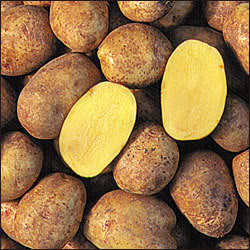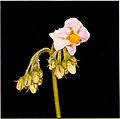Yukon Gold potato facts for kids
Quick facts for kids Potato 'Yukon Gold' |
|
|---|---|

The golden yellow flesh of the 'Yukon Gold' potato
|
|
| Genus | Solanum |
| Species | Solanum tuberosum |
| Hybrid parentage | 'Norgleam' × W5279-4 |
| Cultivar | 'Yukon Gold' |
| Origin | Ontario, Canada |
The Yukon Gold is a popular type of potato. It's known for its thin, smooth skin and its bright yellow inside. This special potato was created in the 1960s in Guelph, Ontario, Canada. A person named Garnet ("Gary") Johnston, with help from Geoff Rowberry at the University of Guelph, developed it. The first official cross-breeding happened in 1966. Finally, the 'Yukon Gold' potato was ready for everyone to buy in 1980.
Contents
Cooking Your Yukon Gold Potatoes
'Yukon Gold' potatoes are super versatile in the kitchen! Unlike some other potatoes, they work well with many different cooking styles. You can cook them with dry heat, like baking or frying. They also do great with wet heat, such as boiling.
Their moist, slightly waxy inside and sweet taste make them perfect for:
- Boiling
- Baking
- Frying
But don't stop there! These potatoes are also delicious when:
- Grilling
- Pan frying
- Roasting
A medium-sized 'Yukon Gold' potato (about 150 grams) gives you good nutrition. Here's what you get (percentages are based on a 2,000-calorie diet):
- Calories: 110
- Fat: 0 g
- Sodium: 10 mg
- Potassium: 770 mg
- Total Carbs: 26 g (9%)
- Dietary Fibre: 2 g (8%)
- Sugars: 3 g
- Protein: 3 g
- Cholesterol: 0 mg
- Vitamin A: 0%
- Vitamin C: 50%
- Calcium: 2%
- Iron: 15%
How Yukon Gold Potatoes Grow
Yukon Gold potatoes have some unique features that help them grow well.
What Makes Them Special?
- They were created by mixing two types of potatoes: 'Norgleam' and W5279-4. This happened at the University of Guelph.
- They were officially registered in 1980.
- The plants are ready to harvest in the middle of the growing season.
Plant Parts and Looks
- Leaves: They are olive green, a bit thin, and spread out from the stem.
- Flowers: These are light purple with a yellow-green star in the middle. The purple color gets lighter towards the edges.
- Buds: The buds can be light green or a mix of purplish green.
- Tubers (Potatoes): The potatoes themselves are oval-shaped and slightly flat. They have smooth surfaces and shallow "eyes" (the small dents where sprouts can grow).
- Skin: The skin is light yellow to light golden brown, with yellow flakes.
- Flesh: The inside of the potato is bright yellow and holds a lot of moisture.
- Sprouts: When they start to grow, the sprouts are reddish-purple.
Farming and Harvest
- Yield: These potatoes produce a medium to high amount of potatoes per plant.
- Hollow Heart: Sometimes, very large 'Yukon Gold' potatoes can have a hollow space in the middle. This is called "hollow heart."
- Storage: They store really well! They have a long "dormancy phase," which means they don't sprout quickly. It's best to keep them in a cold, dark place.
Potato Problems and Diseases
Like all plants, 'Yukon Gold' potatoes can get sick. Here's how they stand up to different problems:
Very Susceptible (easily gets these):
- Seed decay (seeds rot)
- Blackleg (a stem rot)
- Early blight (a leaf disease)
- Late blight (another serious leaf disease)
- Early dying (plants die too soon)
- PVY (a common potato virus)
- Soft rot (potatoes turn mushy)
- Dry rot (potatoes dry out and rot)
- Leak (a wet rot)
- Pink rot (a pinkish rot)
- silver scurf (a skin disease)
- black scurf (another skin disease)
Susceptible (can get these):
- common scab (bumpy spots on the skin)
Moderately Tolerant (can handle these a bit):
- Leaf roll (leaves roll up)
Tolerant (can handle these well):
- PVX (another potato virus)
Storing Your Yukon Gold Potatoes
'Yukon Gold' potatoes are great for storing because they don't bruise easily. They also don't sprout a lot, thanks to their good dormancy. This means they stay fresh longer. If you store them correctly, they won't lose much moisture compared to other potato types.
It's important to check that the lenticels (tiny pores on the skin) are not swollen. Also, make sure the skin isn't bruised. If these things happen, it can lead to big rot problems for your potatoes.









